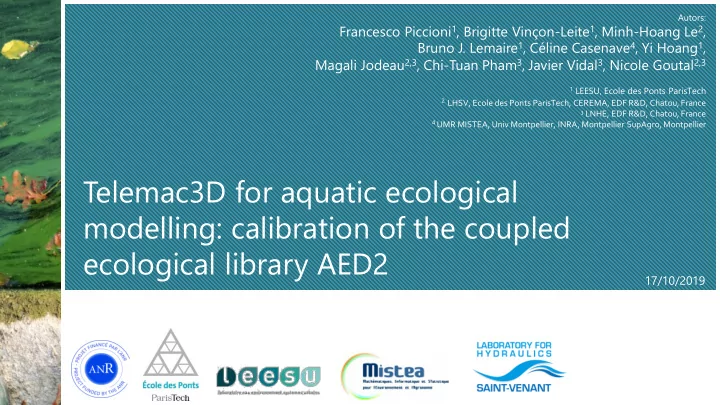

Autors: Francesco Piccioni 1 , Brigitte Vinçon-Leite 1 , Minh-Hoang Le 2 , Bruno J. Lemaire 1 , Céline Casenave 4 , Yi Hoang 1 , Magali Jodeau 2,3 , Chi-Tuan Pham 3 , Javier Vidal 3 , Nicole Goutal 2,3 1 LEESU, Ecole des Ponts ParisTech 2 LHSV, Ecole des Ponts ParisTech, CEREMA, EDF R&D, Chatou, France 3 LNHE, EDF R&D, Chatou, France 4 UMR MISTEA, Univ Montpellier, INRA, Montpellier SupAgro, Montpellier Telemac3D for aquatic ecological modelling: calibration of the coupled ecological library AED2 17/10/2019
Introduction Materials and methods Results Further steps Context Urbanization C/N/P HABs Climate change (Figure from: H. Paerl, 2014) - Urbanization - Heavy precipitation A complex ecological library AED2 (Aquatic EcoDynamics) has been Washes additional nutrients recently coupled with TELEMAC3D Global ………...…. warming Favors cyanobacteria 2
Introduction Materials and methods Results Further steps Objectives First calibration of the coupled T3D / • AED2 in a natural ecosystem Through high-frequency biological • data (10 mins) on a short 2-weeks period In terms of: • thermal stratification (temperature) – Biology: [Chl-a], [O 2 ], [Cyanobacteria] – Validation tests: - July 2015 Calibration: July 2018 - July 2016 3
Introduction Materials and methods Results Further steps Study site Lake Champs-sur-Marne Surface: 0.12 km 2 o Mean depth: 2.5 m o Max depth: 4 m Temp. o O 2 Recreational area Chl-a Cyano. Severe cyanobacteria blooms High-frequency data since 2015: Chl-a fluorescence o Phycocyanin fluorescence o DO o Water temperature o 4
Introduction Materials and methods Results Further steps TELEMAC 3D: set up and domain Grid & bathymetry : via BlueKenue • - 620 nodes - Interpolated bathymetry - 10 layers, σ -transformation Hydrodynamics • - Turbulence closure model: mixing length 100 m + Damping function - Activated air-water heat exchange Main heat exchange parameters - Meteorological forcing: Wind reduction coefficient 0.00135 [-] Orly airport, (Météo France) Vertical diffusion 10 -6 m 2 /s Light extinction coefficient Computed by AED 5
Introduction Materials and methods Results Further steps AED2: main characteristics Activated modules : • Oxygen – Carbon – Inorganic nutrients – Organic matter – (PON, DON) Phytoplankton – 2 phytoplankton • groups: Green algae – Cyanobacteria – 6
Introduction Materials and methods Results Further steps AED2: main parameters Green Algae Cyanobacteria I. C. Max growth rate 1.4 1.1 Wat. Temp. 25.5 ° C O 2 225 mmol O 2 / m 3 Resp. rate 0.17 0.14 C / Chl-a 30 40 DIC 800 mmol C / m 3 Temp. coefficient 1.08 1.09 pH 7.5 Optimal temp. (Min- 26 ° C (20-33 ° C) 28 ° C (19-36 ° C) Ammonium 2 mmol N / m 3 Max) Nitrate 0.5 mmol N / m 3 Half-Sat. const. for light 10 μ E m -2 s -1 15 μ E m -2 s -1 Si 12.5 mmol Si / m 3 limitation (IK) P 0.3 mmol P / m 3 Half-Sat. conc. of 0.9 (mmol N m -3 ) 0.4 (mmol N m -3 ) Green agae 7 mmol C / m 3 nitrogen (KN) Cyanobacteria 9 mmol C / m 3 Nutrient and mineralization Nitrification rate 1.4 d -1 Source: AED2 manual DON (PON) mineral. Rate 0.12 d -1 (0.4 d -1 ) • Gal et al., 2009 Half sat. const. (for nitrif. And mineral.) 78.1 mmol N m -3 • Trial and error calibration • Sediment Oxygen demand 10 mmol O 2 m -2 d -1 7
Introduction Materials and methods Results Further steps Results Calibration period, July-August 2018 Temperature: thermal stratification • [Chl-a], [O 2 ], [Cyanobacteria] • Validation tests: July 2015, 2016 Temperature • [Chl-a], [O 2 ] • 8
Introduction Materials and methods Results Further steps Calibration period: august 2018 9
Introduction Materials and methods Results Further steps Calibration period: august 2018 10
Introduction Materials and methods Results Further steps Validation test: 2015 11
Introduction Materials and methods Results Further steps Validation test: 2016 12
Introduction Introduction Materials and methods Materials and methods Results Results Discussion Further steps Discussion and further steps Model results are satifying in terms of surface water • temperature; bottom water temperature is overestimated The biogeochemical library is able to correctly reproduce • Dynamics of growth and mortality over short periods – The timing and the concentration of the peak of growth – Complete validation: • vertical profiles – remaining measuring sites – longer simulation periods – Meteorological data need to be carefully assessed • Nutrient input dynamics into the lake need to be better • assessed 13
THANK YOU ! 14
Introduction Materials and methods Results Further steps Calibration period: inorganic nutrients NH4 NO3 PO4 15
Introduction Materials and methods Results Further steps Mixing length and damping function Mixing length model: expresses the turbulent viscosity 𝜉 (or diffusion coefficient) as a function of the mean • velocity gradient and the mixing length (Prandtl’s theory): 𝑘 𝑗 𝜖𝑉 1 𝜖𝑉 𝐸 𝑗𝑘 𝐸 𝑗𝑘 , with: 𝐸 𝑗𝑘 𝜖𝑦 𝑗 2 𝜉 = 𝑔(𝑆 𝑗 )𝑀 𝑛 𝜖𝑦 𝑘 + 2 Damping function: Mixing reduction into a stable stratified: a damping function can be introduced into the • turbulence mixing length model according to the Richardson number. 𝛼𝜍 𝑔(𝑆 𝑗 ) = (1 + 14𝑆 𝑗 ) −0.75 , 𝜍 𝛼𝑣 2 𝑆 𝑗 = R i is the Richardson number: • ratio between the buoyancy terms and the flow shear stress. Used to quantify the effects of the gravity terms in the turbulent power balance 16
Introduction Materials and methods Results Further steps Calibration period: august 2018 17
Recommend
More recommend